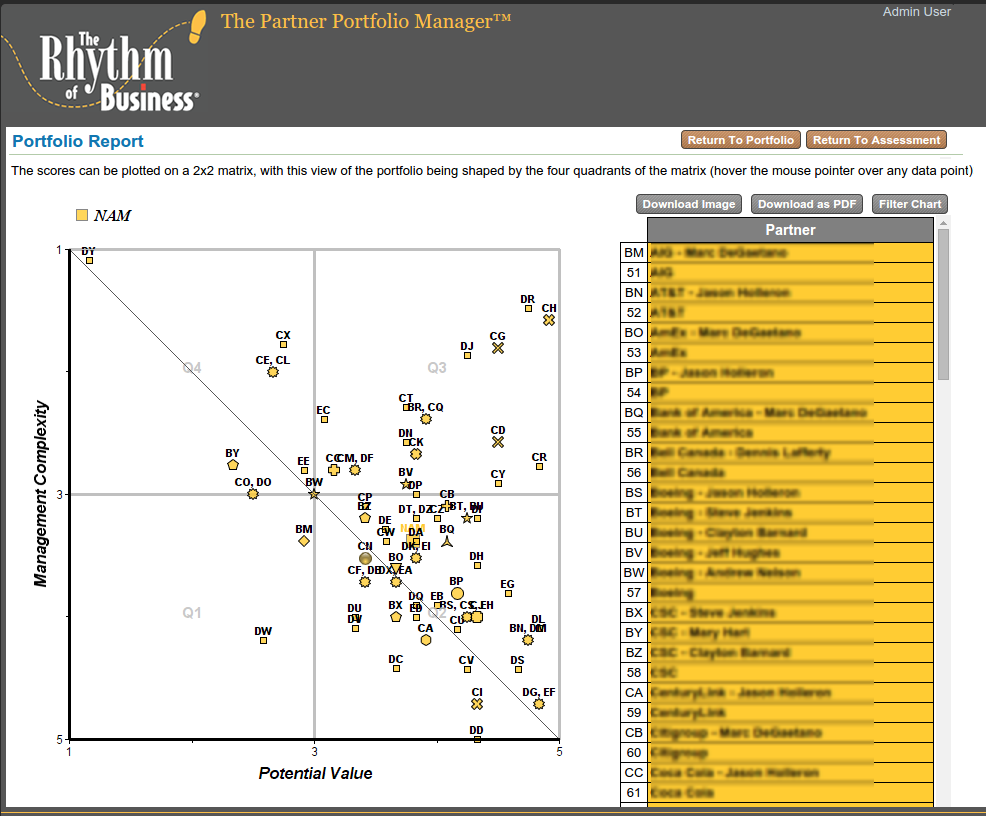Alliance Management
 To encapsulate the rich portfolio management process set out in the Association of Strategic Alliance Professionals (ASAP) Practitioner’s Guide, Part Three – “Emerging Alliance Practices”, NIP created the Partner Portfolio Manager in partnership with The Rhythm of Business.
To encapsulate the rich portfolio management process set out in the Association of Strategic Alliance Professionals (ASAP) Practitioner’s Guide, Part Three – “Emerging Alliance Practices”, NIP created the Partner Portfolio Manager in partnership with The Rhythm of Business.
Using the 2×2 matrix capabilities of NIP’s ARC Diagnostic framework, the two axes – Value and Complexity – are independently driven by a configurable set of parameters, which are then typically completed by a number of participants to position members of the portfolio, and generate a host of supporting reports.
Instigated as an alliance management tool, it is also used for sales channels – including by Symantec and Red Hat, the world’s leading provider of open source solutions – and can be adopted for supply chain relationships, too.
Here’s how ASAP describe the relevance of portfolio and capability management:
Creating an alliance network or developing a portfolio of partners doesn’t occur at any one stage of the alliance life cycle, but rather overlays all of them. Additionally, the activities associated with building a network or portfolio are often concurrent; an organization can be adding a new partner to its network while managing and even terminating others. Alliance capability is similar in that there is no one stage of the life cycle where capability switches on or off. It is true that some aspects of capability and culture are utilized more at some stages of the life cycle than others, but these are actually crucial throughout the entire life of an alliance.
Functionality:
- Web-based managed service, managed by NIP, but can be run by an external consultant or taken ‘in-house’.
- Automated participant invitations, reminders and progress tracking.
- Customisable parameters for each axis.
- Capture of parameter scoring and related issues.
- Reports updated in real-time.
Additional options:
- In-depth gap analysis between organisations, departments, functional teams, etc.
- Capture suggested improvement actions.
- Recommended actions (Improvement Report).
- Export comments and suggested improvement actions to action management tool.
- Categorise relationships for category-based reporting.
- Categorise participant under ‘roles’, for role-based reporting.
- Facilitator/Practitioner support.
- Repeating the process periodically.
- Benchmarking across a portfolio.
How it works:
- One-to-many relationships, with one-way measurement (survey mode) inviting:
- Our relationship managers to review our partner’s capability/performance, and/or
- Our partners to assess our organisation’s capability/performance.
- Hybrid portfolios of one-way and mutual measurements.
Learn more:
Presentation about how Red Hat Software use the Partner Profile Manager to take a strategic approach to their portfolio of sales channel partners (given at the 2014 ASAP Global Alliance Summit). (PDF)